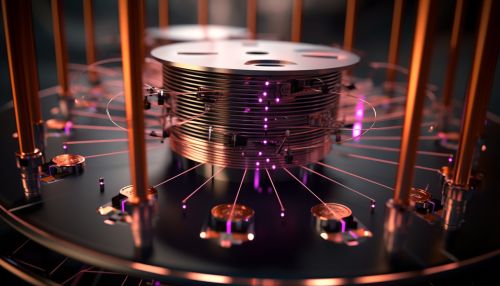Trapped ion quantum computer
Introduction
A Trapped ion quantum computer is a type of quantum computer that utilizes individual ions as quantum bits, or qubits. These qubits are held in place by electromagnetic fields and manipulated by lasers or microwave radiation to perform quantum computations. The trapped ion quantum computer is one of the most promising architectures for building a scalable, universal quantum computer due to its long coherence times, high-fidelity operations, and potential for scalability.
Principle of Operation
The operation of a trapped ion quantum computer is based on the principles of quantum mechanics, particularly quantum superposition and entanglement. Each ion in the trap can be thought of as a qubit, the fundamental unit of quantum information.


The internal energy levels of the ions are used to represent the binary states of a qubit: the ground state represents the binary '0' and an excited state represents the binary '1'. Through the use of lasers or microwave radiation, these ions can be manipulated to perform quantum logic gates, the building blocks of quantum algorithms.
Ion Trapping Techniques
There are several techniques for trapping ions, including Paul traps and Penning traps. These traps use a combination of static and oscillating electric fields to confine the ions in a small region of space. The choice of ion trap can have a significant impact on the performance and scalability of the quantum computer.
Quantum Logic Gates
In a trapped ion quantum computer, quantum logic gates are implemented by applying laser or microwave pulses to the ions. These pulses can cause the ions to transition between their internal energy states, resulting in a change in the state of the qubits. Additionally, the interaction between ions can be used to create entanglement, a key resource for quantum computation.
Scalability and Challenges
While trapped ion quantum computers have demonstrated high-fidelity operations and long coherence times, there are several challenges that must be overcome to scale up these systems to a large number of qubits. These include the difficulty of maintaining stable ion traps over long periods of time, the need for precise control of laser or microwave pulses, and the challenge of performing operations on arbitrary pairs of qubits.
Applications
Trapped ion quantum computers have the potential to revolutionize a wide range of fields, from cryptography and optimization to quantum simulation and machine learning. However, the development of practical applications for these systems is still in its early stages, and much research is needed to fully realize their potential.
